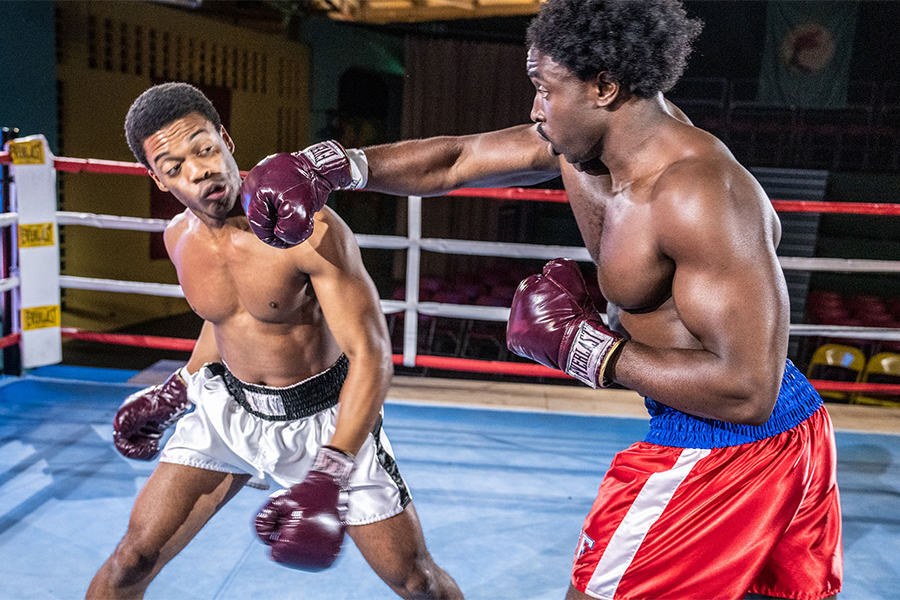How do you go from knocking an idea around to delivering a knockout experience?
Rumble in the Jungle Rematch was one of our favourite London experiences of 2023.
Called “a knockout” by The Times, “an all-enveloping affair that rewards the curious and the adventurous” by Theatre News, and “a spectacle from start to finish” by Immersive News, this immersive production transported audiences back to Muhammad Ali and George Foreman’s epic 1974 clash in Zaire.
It’s one of the first experiences by Rematch, a part-theatre, part-festival mash-up that aims to transport audiences back in time to some of the most iconic stories in sport, leveraging its incredible power, nostalgia and cultural cachet. Each unique live experience uses archive footage, live actors, choreography, music, special effects, food and drink and more to build a miniature world.
Having launched in September 2023, Rumble in the Jungle Rematch did 78 performances, saw up to 750 people per night, and had an average ticket price of around £62 (with VIP tickets that included experiences like going into Ali’s dressing room, merch, drinks and cool perks also available).
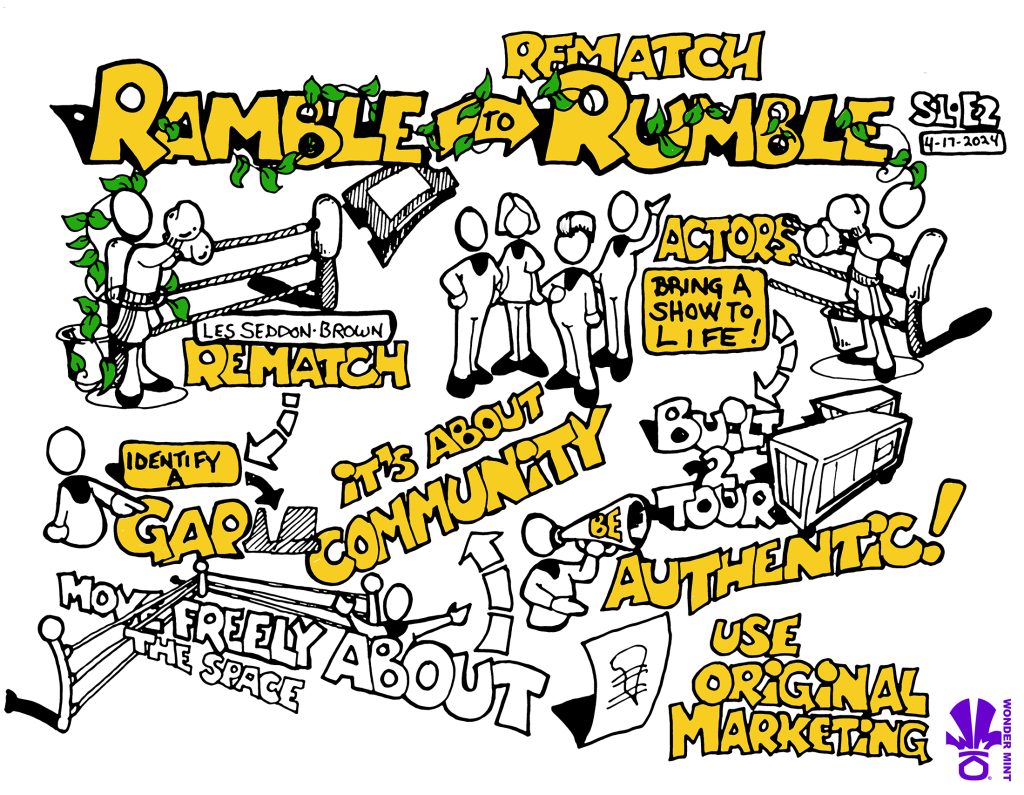
We were delighted to welcome Rematch’s CEO, Les Seddon-Brown, to recount how he went from the seed of an idea to a fully formed business.
You’ll learn how Rematch combined theatre, sport and technology to evoke the sights, sounds and smells of Kinshasa for a broad audience of experience junkies and newbies – as well as what they learned about being an experience entrepreneur from the brutal bumps and hurdles along the way.
Defining The Concept: The Rumblings Of An Idea
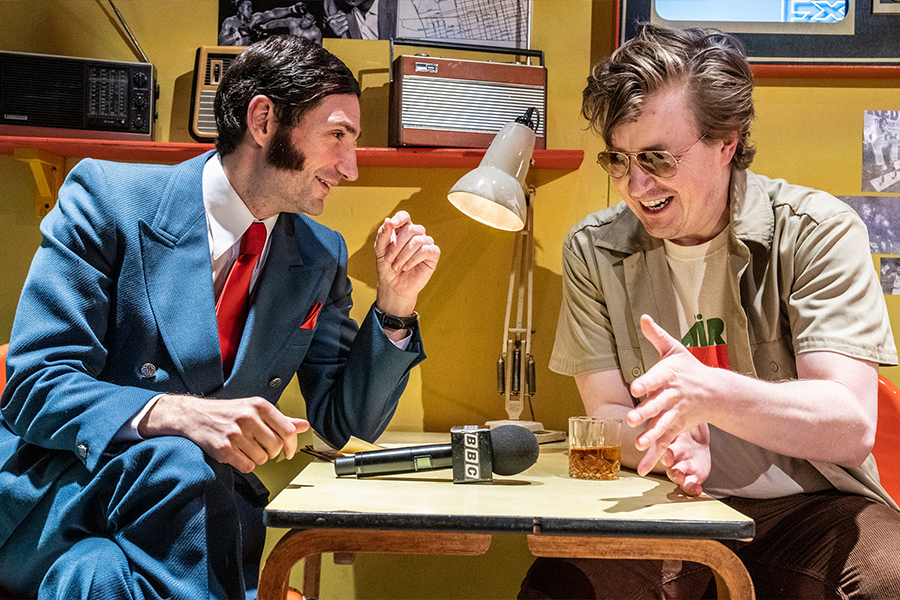
“Think of a great sporting moment in the last 100 years you wish you could have attended. Now imagine if we could sell you a ticket…”
This is the key hook behind Rematch, and the question that Seddon-Brown was asked by the company’s founder, Richard Ayers, in the early days of the project. The more they developed the idea, the more they understood that these moments are bigger than sports: they become part of the cultural zeitgeist.
9 out of 10 people will have a moment like this – and they’ll also remember where they were and who they were with when it happened. This opportunity to build a world around a story that was much broader than sport, but also took in politics, film, music and fashion, brought together Seddon-Brown’s previous experience in festivals, music, corporate events and brand experience, and he and Ayers decided to dive deeper into this seed of an idea.
Creating The Building Blocks: The 6 Pillars Of A Rematch Live Experience
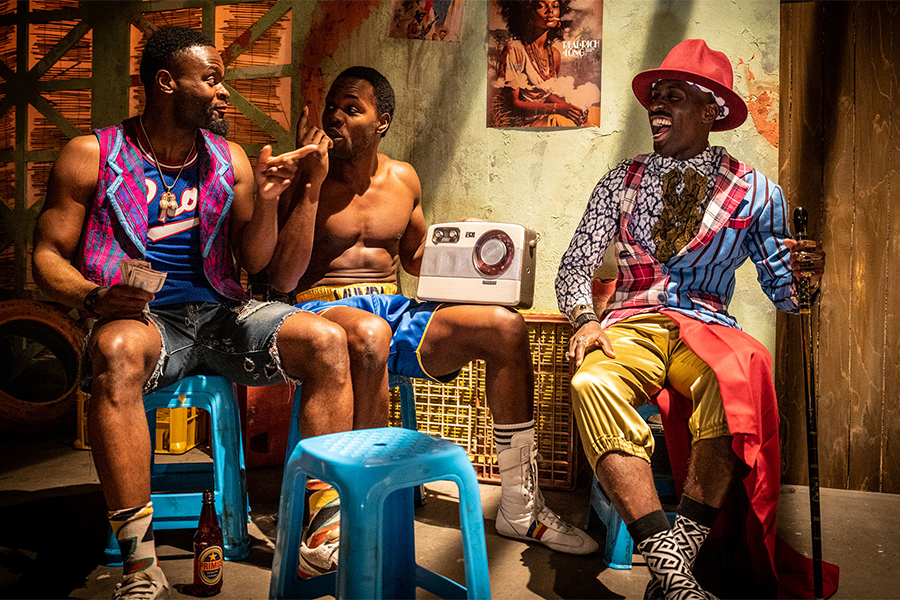
When thinking about what a Rematch experience might look like, Seddon-Brown devised 6 pillars that every experience would have as a steer, regardless of the specific sporting moment:
- Venue
- Actors: the lifeblood of the show
- Music: has the power to transport you to a place and leverage nostalgia
- Food: smell in particular can bring you back somewhere instantly
- Fashion: by asking people to come dressed up if they want to
- Fun: while these can be emotional stories, the audience should leave having had a good time
Defining The Vision: Reaching New Audiences Through Sports

“Sport has the power to change the world. It has the power to inspire. It has the power to unite people in a way that little else does.”
Nelson Mandela
Sport is home to many powerful and transcendent stories. Rematch wanted to develop a set of values, mission and vision that reflected this, using the magic of sport to get a message of connection across.
The vision they came up with was that:
“Generations and communities across the world are inspired to be more connected with each other by experiencing the biggest and best stories in sport in an innovative way.”
This vision was certainly realised in Rumble in the Jungle Rematch, which had guests ranging in age from two to 90 and saw people coming with their kids or parents. They also succeeded in bringing in a mix of communities, from grizzled white English boxing fans to Congolese diaspora families, and Ali mega-fans to those who had never heard of him. This ability to design for fans and superfans, skimmers and divers, is central to its appeal.
The audience stats for the run were:
- 59% non-white
- 51% female
- 44% first immersive show
- 37% Ali fans
- 23% never been to a theatrical show
Proving The Concept: A Unique Opportunity To Leverage IP

Rematch didn’t only seem like a brilliant creative idea, but also a brilliant opportunity to expand immersive into a new space. Sport is booming as an industry, but there’s a question of where to go from here. Sporting rights holders are looking for a way to monetise and export their brands to new markets, amazing IP is just sitting in the archives, and sport is fighting for younger audiences’ attention.
Rematch solves a lot of these problems. It’s a new kind of asset blending the arts and sports, and hasn’t been done in either the live sport or immersive spaces. It’s a tourable format that can be adapted to new markets. It opens up new audiences and appeals to younger ones. And it taps into pre-existing stories of rivalry and adversity and retells them for a fresh audience.
Seddon-Brown had the opportunity to put all this to the test after a fortuitous meeting with Wimbledon led to Wimbledon Rematch 1980, a limited run of 5 shows the week before the annual tournament. This enabled them to test the concept and see if they could turn a four-hour tennis match into something fun, emotional and interesting.
They used projection mapping to build the court, two giant screens to screen the action, and choreographed pieces using Wimbledon clichés like ball boys. The run was a success, winning some awards and leading to deals to bring it to the Edinburgh Fringe and with UEFA, but the onset of Covid meant these didn’t come to pass. After spending some time trying to pitch the idea to sports clubs, Rematch decided to raise the money through private investment and licence some rights so they had control to put on the show when they wanted.
Building The Narrative: A Multi-Chapter Show Structure
The structure for Rumble in the Jungle wasn’t purely story-driven or actor-driven, but sat somewhere in the middle. It’s part free-flow, with an initial section where you can create your own journey as you explore a festival, get food and drink, and interact with the live cast. The second section is the sporting moment, which is more of a sit-down performance with audience participation.
Seddon-Brown splits the show into a narrative structure with six chapters and a prologue:
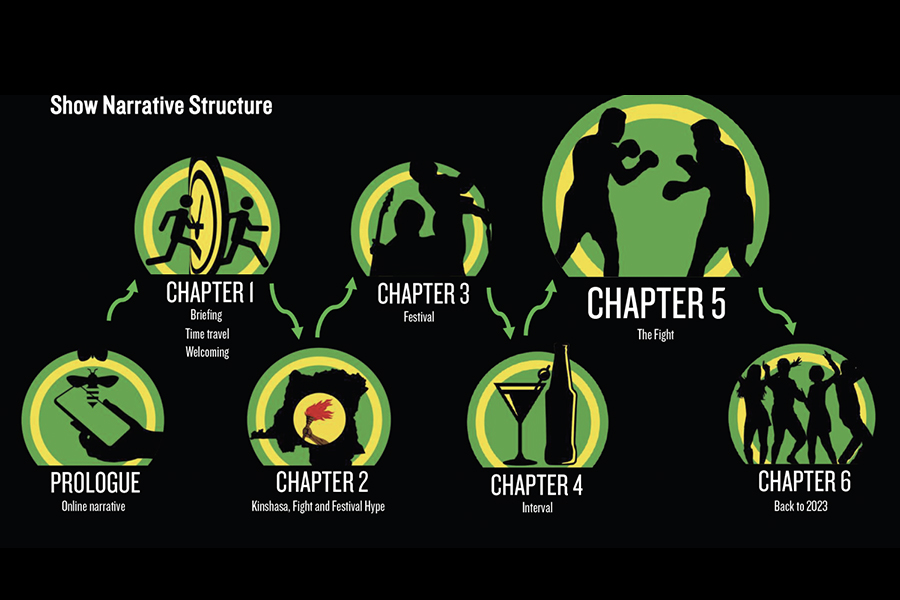
Waves of 150 people at a time arrived in an antechamber for an introduction and time travel moment, before the doors to “Kinshasa” opened. Once in, they have two hours to roam freely before a performance brings everyone together in one space, and then the ring is revealed.
Getting The Show Off The Ground: From Setbacks To Success
After all this preamble, it was finally time to get the show rolling. Seddon-Brown outlines the six steps that took it from funding to live performance.
- Funding and licensing
The first step was to raise investment, which the team managed to achieve in the millions despite raising money for live events in the wake of the pandemic, when more investment was going into digital. They also had to find who owned the rights and what they could use, which took over 18 months to untangle and secure a 10-year exclusive licence.
- Building the team
Seddon-Brown and his team were acutely aware that they were three white, middle-aged, male founders trying to tell a story of Black empowerment, and that they needed a Black person to tell this story authentically. The immersive space still lacks in diversity, so finding the right director and writer was a challenge – they ended up interviewing about 30 different directors and many pulled out before the production, as they were in high demand.
Eventually they got to director Miguel H Torres Umba and writer Tristan Fynn-Aiduenu, who brought a new way of looking at the project that added women into the story and thought about the perspective of the local Congolese population of the time rather than relying on its presentation in the Western media.
It was also important to get diversity throughout the creative team, from lighting to sound and beyond. This sometimes meant taking a leap of faith on people with less experience and giving them the opportunity to learn about this medium and trust that they’d deliver.
- Securing the venue
This proved a tricky piece of the puzzle: after 18 months the team found their perfect venue, and old sports hall in central London called Seymour Hall. It had everything they wanted, but due licencing issues they ended up having to pull the event from sale and losing the venue, losing several directors and creatives in the process as they couldn’t wait six months to restart. It also meant a financial hit and some difficult conversations with investors.
However, the team ended up finding another home for the show, Dock X in Canada Water. Although this was more of a “black box” and probably slightly too big, it proved a lucky find in the long run, as the long-term vision was for a transferable design that would be easier to replicate in other markets.
- Developing the show
Following research, writing and set design, this moved on to casting, which was hardest for the roles of Ali and Foreman. Two actors were needed for each role in case of injury, and the analogie nature of the show meant that they had to learn all the moves in the face of fans who would pick apart any errors. A lot of time was spent on research and development to understand how to best use archive footage, settling on three different methods: live camera on actors beamed to screen, pre-recorded footage with actors, and original archive footage.
- Marketing the show
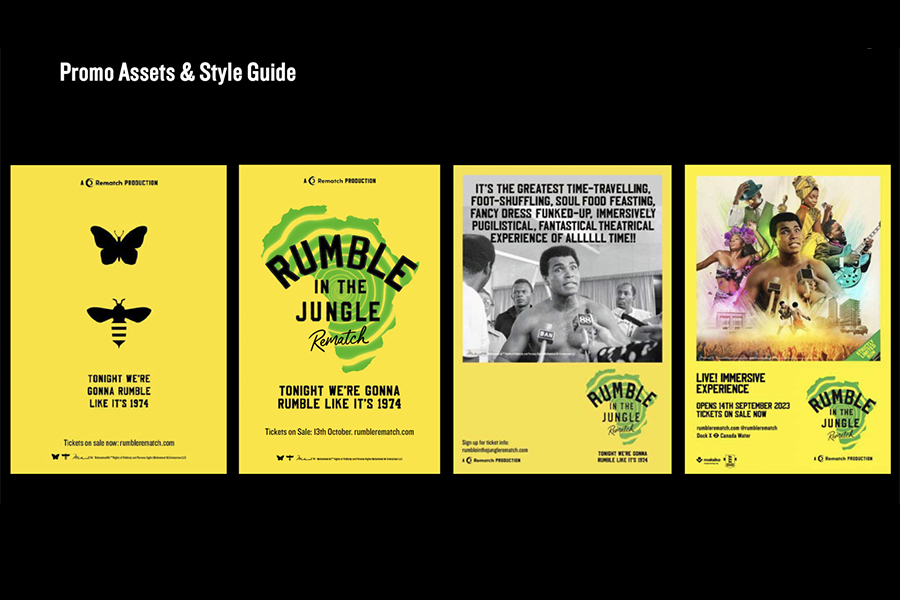
As a new company with no pre-existing database, no proof of what the show looked like, and not knowing quite what the show would be until late in the process, this presented some challenges. The team worked with advertising legend – and show investor – Trevor Beattie, a die-hard Ali fan who created a multi-layered campaign teasing the show using butterfly and bee imagery and a custom font.
Social media assets seeded the story and brought out the themes of Black empowerment, Africa, music, and the fight, and can now be shared with promoters around the world. The journey to get momentum took time, but by the last week of the show they were selling out dates.
- Staging the show
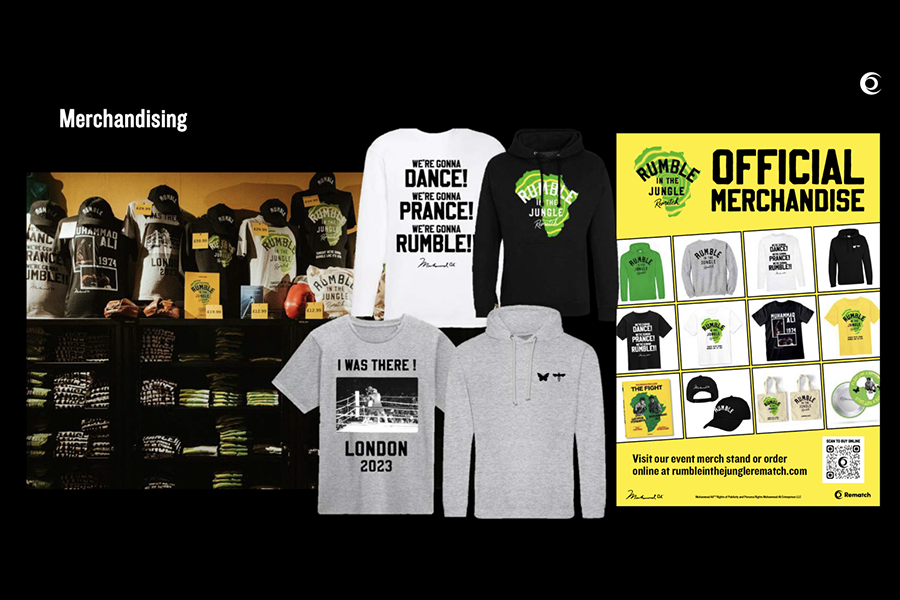
In addition to the work done on the narrative, staging and cast, it was important that the story came across through the food and beverage and merch offering. Rematch found a local Congolese street food outfit to partner with, and also created a beer brand called Le Champion and branded beer cups to take away as a souvenir. The merch was a mix of third-party licensed merchandise, the programme, and visuals from around the event, such as an “I was there: London 2023” t-shirt.
The WXO Take-Out

We think there’s a lot to learn from Rumble in the Jungle Rematch’s journey from ramble to rumble – not only creatively, but commercially, too.
As a commercial opportunity, it’s an example of creating something that can tap into existing IP, connect with new audiences, and be transferred and adapted for different markets, creating the potential for longevity.
And as a creative idea, it proves the power of a story that people can latch onto, whether from the world of sport or elsewhere.
So next time you’re creating an experience, ask yourself:
- How do you include the six pillars of venue, actors, food, music, fashion and fun in your experience?
- How might you open up your experience to connect with new audiences?
- What opportunities are there to leverage existing IP and stories in your experiences?
Enjoyed this? You might find these articles interesting:
- 8 Ways To Make Your Merch Memorable
- The Economics Of Immersive
- 3 Worldbuilding Lessons From Wake The Tiger
- How To Design Experiences For Fans & Superfans
Want to come to live Campfires and join fellow expert experience creators from 39+ different countries as we lead the Experience Revolution forward? Find out how – and the current speaker line-up – here.

